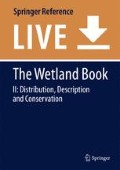Abstract
The importance of coastal saline salt flats along the southern and western Arabian Gulf coast (known as sabkha) is discussed. Sabkha landforms are being rapidly converted for industrial and urban coastal expansion. In Abu Dhabi, sabkha has also been successfully converted to productive saline agro-systems using both local mangrove (Avicennia marina) and saline tolerant algae (Dunaliella salina). The mangrove systems have developed into productive forest ecosystems supporting local fisheries. The algae systems developed in ponds within sabkha have produced a natural pharmaceutical (beta-carotene), biomass and oil for production of biofuel. The use of sabkha landforms as a sink for heated saline brine produced by the desalination and industrial use of seawater is preferable than its current discharge to the marine environment where it is causing ecological impacts. The alteration of sabkha landforms into saline agro-systems is argued to be more productive than the permanent conversion of these same landforms for industrial or residential development.
References
Barth H-J, Böer B, editors. Sabkha ecosystems. Dordrecht: Kluwer; 2002. p. 363.
Blasco F, Saenger P, Auda Y, Aizpuru M, Loughland RA, Youssef A. Mapping main coastal habitats and mangroves. In: Loughland RA, Al Muhairi FS, Fadel SS, Al Mehdi AM, Hellyer P, editors. Marine atlas of Abu Dhabi. Abu Dhabi: Emirates Heritage Club; 2004.
Chisti Y. Biodiesel from microalgae. Biotechnol Adv. 2007;25:294–306.
Curtis R, Evans G, Kinsman DJJ, Shearman DJ. Association of dolomite and anhydrite in the recent sediments of the Persian Gulf. Nature. 1963;197:679–80.
Evans G, Kirkham A. The Abu Dhabi sabkhat. Distribution of sabkhat in the Arabian Peninsula and adjacent countries. In: Barth H-J, Böer B, editors. Sabkha ecosystems. Dordrecht: Kluwer; 2002. p. 353.
Evans G, Schmidt V, Bush RP, Nelson H. Stratigraphy and geological history of the sabkha, Abu Dhabi, Persian Gulf. Sedimentology. 1969;12:145–59.
Loughland RA, Cunningham PL. Vertebrate fauna of Sabkhat from the Arabian Peninsula: a review of Mammalia, Reptilia and Amphibia. In: Barth H-J, Böer B, editors. Sabkha ecosystems. Dordrecht: Kluwer; 2002. p. 255–66.
Loughland RA, Saji B. Remote sensing: a tool for managing marine pollution in the Gulf. In: Barth H-J, Böer B, editors. Gulf ecosystems. Dordrecht: Kluwer; 2007.
Loughland RA, Saenger P. Report to the Public Works Department of Abu Dhabi on the methods for the development of mangrove plantations in Abu Dhabi Emirate. Abu Dhabi: Department of Environmental Research, Emirates Heritage Authority; 2001
Loughland RA, Wyllie A, Al-Abdulkader K. Anthropogenic induced changes along the Gulf coast of KSA from 1967–2010. In: Piacentinj T, editor. Geomorphology. Rijeka: Intech; 2011. p. 333.
Negoro M, Shioji N, Miyamoto K, Miura Y. Growth of microalgae in high CO2 gas and effects of SOx and NOx. Appl Biochem Biotechnol. 1991;28–9:877–86.
Qurban M, Kumer K, Al-Abdulkader K, Loughland RA. Overview of the marine and coastal habitats. In: Loughland RA, Al-Abdulkader K, editors. Marine atlas of the Western Arabian Gulf. Saudi Aramco: Kingdom of Saudi Arabia; 2011. p. 455.
Saenger P, Blasco F, Loughland R, Youssef A. In: Salim Javid, de Soyza AG, editors. Research and Management Options for Mangrove and Salt Marsh Ecosystems – Proceedings of the 2nd International Symposium and Workshop on Arid Zone Environments (22–24 Dec 2001, Abu Dhabi, UAE). Abu Dhabi: Environmental Research and Wildlife Development Agency (ERWDA); 2002. p. 196–8
Sheppard C, Loughland R. Coral mortality and recovery in response to increasing temperature in the southern Arabian Gulf. Aquat Ecosyst Health Manage. 2002;5(4):1–8.
Sheppard C, Al-Husiani M, Al-Jamali F, Al-Yamani F, Baldwin R, Bishop J, Benzoni F, Dutrieux E, Dulvy NK, Rao S, Durvasula V, Jones DA, Loughland RA, Medio D, Nithyanandan M, Pilling GM, Polikarpov I, Price A, Purkis S, Riegl B, Saburova M, Namin KS, Taylor O, Wilson S, Zaina K. The Gulf: – a young sea in decline. Mar Pollut Bull. 2010;60:13–38.
Author information
Authors and Affiliations
Corresponding author
Editor information
Editors and Affiliations
Rights and permissions
Copyright information
© 2016 Crown Body - Her Majesty the Queen in Right of Australia
About this entry
Cite this entry
Loughland, R.A., Qasem, A.M., Burwell, B., Prihartato, P.K. (2016). Coastal Sabkha (Salt Flats) of the Southern and Western Arabian Gulf. In: Finlayson, C., Milton, G., Prentice, R., Davidson, N. (eds) The Wetland Book. Springer, Dordrecht. https://doi.org/10.1007/978-94-007-6173-5_185-3
Download citation
DOI: https://doi.org/10.1007/978-94-007-6173-5_185-3
Received:
Accepted:
Published:
Publisher Name: Springer, Dordrecht
Online ISBN: 978-94-007-6173-5
eBook Packages: Springer Reference Biomedicine and Life SciencesReference Module Biomedical and Life Sciences

